They are kind of like a personal Seed Bank. The concept of a Survival Seed Kit is to have seeds stored for an emergent long duration crisis that will deplete your food storage so that growing food becomes a necessity to staying alive over the long haul.
There are various companies that sell seeds for survival packed in cans or mylar bags, PVC tubes, or cans or some other long term storage set up. They are named such things as “survival seed vault”, “survival seed bank”, or just “survival seeds”. They are usually a collection of non-hybrid seeds put together as a package to grow an entire garden and sold with the assumption that you can store them with your food storage and pull them out and plant them when there is an emergency of sufficient significance as to require you to grow your own food indefinitely.
Sounds perfect doesn’t it? Don’t count your chickens before they are hatched!
According to Native Seed SEARCH: "At one time, seed saving was a necessity. Gardeners and farmers carefully selected and stored the best seeds from their harvests, ensuring they had seed for planting in subsequent years. The knowledge of pollination, purity, harvesting and storage of seeds was all part of survival and learned within the family and community."
The rise of commercially available seed resulted in a trend away from seed saving. Add to that the advent of hybrid (1950's) and GM (1980's) seed, which require purchasing seed each growing season, compounded the knowledge drain on seed saving and contributed to the habit of farmers and gardeners simply purchasing new seed every year.
In the late 1970's world governments, botanical gardens and universities jumped on the “genetic diversity” bandwagon by implementing various national and international seed bank projects and exchanges. The famed "Doomsday Vault" or Svalbard Global Seed Vault, is just one of many. (See The world’s 15 largest seed banks by AG Professional)
Today, the self-reliance or “back to the land” and “prepper” movements recognize of the importance of crop genetic diversity and the old skills of saving one’s own seed. This is exemplified by the many local, regional and national efforts devoted to conserving the heirloom and traditional varieties or plants that were once so prevalent.
The science behind storing seeds and protecting its germination viability for a long time in order to sprout them later, is still somewhat in its infancy.
What's known is there's a lot of different criteria regarding storing different seeds for long term storage. It seems that every kind of seed has its own unique criteria for long term storage. Some seeds store better in air. Others store better in nitrogen, and still others do better in a vacuum, carbon dioxide or argon. And others seem to be tolerant to all the different gasses. Very specific moisture and temperature controlled refrigerators or freezers are also common with commercial seed banks and some seed exchanges.
Now how many of us every day John & Jane Doe’s have the space and funding to have professionally vacuum sealed and a scientifically regulated refrigerated or freezer at our disposal for seed storage?
Storing any seed has basically the same needs, which are the opposite of what they need to germinate: low to no humidity, low to no oxygen (air), low to no UV light and cool temperatures. This means the seeds must be dry before storing and in air tight containers.
Moisture and Temperature are the two biggest variables to storing seeds for the long haul.
- Generally, the colder you store them, the longer the seed will remain viable. For really long storage - such as 5-10 years, it's best if you can keep them frozen.
- To get many years of viability out of seeds they need to be dry, generally drier than Mother Nature naturally gets them. Whereas 10% moisture is acceptable for long term storage of seeds for eating, they should be dryer than this if you expect to get years and years out of them for germination viability. 4% moisture seems to be the magic number where extra drying gives no further advantage.
The big seed vaults tend to use glass that is vacuum sealed and store seeds in a special refrigerator, which is a bit cooler than a standard frig, but warmer than a household freezer. Some use various gases to regulate the temperature, while others don’t.
There are several considerations to the container you choose:
- Size of the seed
- Quantity of the seed
- How often you may be "dipping" into the seeds either for planting now or adding to the number of seeds you have stored.
With the above considerations it would pay to keep your long storage seeds separate from your 'until next season' seeds.
Often glass spice jars, canning jars, wide mouth jars, test tubes, vacuum sealed bags (plastic & Mylar), plain paper envelopes and zip lock bags are the containers used by most home gardeners. Basically anything that can be sealed tightly to avoid 'respiration' will work well.
Since different seeds also have different shelf lives, it would be wise to keep 'like shelf life' seeds, that are say packaged in smaller air tight packets, in the same larger air tight container. This way you can rotate them out, to plant and replace at the same time.
- Always label each seed packet or jar with what it is, when and where it was harvested, as well as the date it was harvested. Now that I'm older, my brain doesn't seem to hang to information like it used to, so I now also put on my packets if it needs full or partial sun, the companion plants it 'likes' to be around and its general shelf life (long, medium or short).
My grandmother could tell what seed was what just by looking and touching it. I on the other hand can tell corn and pumpkin, however all the others start to look the same.
I use coin envelopes that are about the size of a commercial seed packet and have a stamp that prompts me to put this information on the envelope. I then place the seed packets into a bag with other plants of the same shelf life and vacuum seal them. Then larger packets then go in either a plastic canister with an air tight lid or a glass jar with an air tight lid.
- If you live in a humid area or are not sure if you have dried the seeds enough for long term storage, you can use a silica packet or some powdered milk with some long cooking rice grains wrapped in cheese cloth or oxygen absorber packet in the container with the seed envelopes, before they are either vacuum sealed, and before they are put in the larger container with like shelf life seeds.
- Should you refrigerate or freeze your seeds, when you are ready to use them, keep the container closed/sealed and let them come to room temperature overnight before opening or planting.
Remember just as each seed is unique, so are its collecting and long term storage requirements.
As mentioned before there are tons of information on how to collect and save seeds for storage. Most of it will be for the year or two short haul for planting. So you may have to dig a little deeper to find out what to do for long term planting viability.
The best places for this information are the organic gardening, botanical garden and university extension service sources. Native Seed SEARCH and Seed Savers Exchange has some very detailed information on specific seeds for long term storage.
Also remember that storing seed for its Nutritional Value has similar, but distinctly different requirements and shelf lives than storing them for Germination Viability.
Their shelf lives will reflect this difference.
For instance wheat for nutritional value is 30+ years, while wheat for germination viability is 5-10+ years.
Sure the science behind storing seeds for the long haul has been able to extend most seeds past their usual 2-5 year shelf life to up to about 10+ years and some much longer in some commercial seed banks. And it is true that we have various historical “exceptions to the rule” where thousand year old seed still germinated. Then there is my own personal experience with my grandmother’s 12+ year old seeds found in a garage, wrapped in newspaper in an open coffee can, where 80% of the seeds still sprouted. However, these are the exceptions and not anywhere near the average. (See Survival Seeds in a Can-9 Years Later)
On average, seed shelf life is as follows:
- “Short-lived” seeds include corn, leek, onion, parsnip, and spinach. These are generally not recommended for more than one season, although they may maintain acceptable germination rates in the second year.
- “Medium-lived” varieties include beans, carrots, celery, chard, eggplant, parsley, peas, pumpkin, salsify, and squash. These varieties, if properly stored, should last up to five years.
- “Long-lived” include the Brassicas (broccoli, Brussels sprouts, cauliflower, cabbage, collards, kohlrabi…) the chicory group (endive, escarole, radicchio), cucumber, kale, lettuce, melons, mustards, peppers, radish, rutabaga, sunflower, tomato and turnips. Stored correctly, these seeds should maintain a good viability for more than five years.
This means that for most of us folks and for community seed exchanges, seeds must be rotated and planted to maintain the “seed library’s” seed germination viability.
Thinking and worse, planning, on these seeds in your survival cache being viable 10 years down the road is more likely to be a deadly mistake to your survival plan than an asset.
If your life is dependent on these seeds growing when needed, trust the averages and not the exceptions!
If you usually purchase pre-sprouted or started plants, growing from seed will pose a learning curve that you must overcome. Do you know how to argument your soil and compost for natural fertilizer? That garden center you go to for this stuff will most likely be empty in a long duration crisis, so there won’t be any help there. Do you know how to companion plant, waffle or square foot gardening or even growing herbs inside year round?
Any learning curving is NOT something you want to be doing for the first time when the chips are down! So if you have never grown your produce from seed, try it NOW, before SHTF.
Don’t think your garden will produce amazing amounts of food if you’ve never planted a seed in the ground before and don’t count on the book or pamphlet that comes with the seed kit as being enough information to grow your own food. I’ve been gardening since I was 10 and I am still learning new things every day.
Survival Seed Kit Disadvantage # 3: Most of these kits only give you one season’s worth of seeds, a few for up to 4 years. The thing is how long will you need to grow your own food?
This means that the owner of these seeds has to know how to Save Seeds from the harvest for the next year’s crop.
In order to save seeds that will produce a replica of the parent plant or “breed true”, the plants must be open pollinated or non-hybrid.
- Non-hybrid seeds have not been cross-bred with any other strain. Non-Hybrid seeds are the most natural and purest form of seed anyone can find. They grow just like they do naturally in nature. Best of all gardeners can save the seeds after each harvest and be assured they will grow the same every time.
- Open Pollinated means the plants are pollinated by insects, bees, birds, wind, and other natural ways. The good thing with open-pollinated plants is that it will continue to reproduce new generations of those plants. Some gardening circles today use open pollinated to mean any seed that is NOT a hybrid seed.
- Heirlooms are open to debate and have no legal definition in the United States, nor is there general agreement on the use of the terms when describing seeds or plants. Heirloom or Heritage Seed is a type of non-hybrid, open pollinated seed. (The term ‘heritage’ is generally used in Europe while ‘Heirloom’ is used in the U.S.) However, some would argue that any seed that has been passed down for generations, usually for 50+ years, is called an heirloom seed. Considering that Heirloom Seeds are from specific regions, you can see why they are NOT necessarily the best pick for survival seeds. After all what if you don’t live in a region similar to the region that created the heirloom seed? The seeds will not produce as well that’s what!
- Heirloom Cultivars: Everyone agrees that all heirloom cultivars are, by definition, open pollinated, even though there is no legal definition that I am aware of. That means heirloom seeds will produce plants that are identical to the parent plants. Traditionally, what is called an heirloom is a cultivar that has been handed down through many generations, often within one family or in a relatively small geographic area.
All Heirloom seeds are non-hybrid and or open pollinated, but not all non-hybrid or open pollinated seeds are heirlooms.
| Hybrid seeds are the offspring of two plants of different species, subspecies or varieties of plants (parents which are genetically distinct). Typically this means the seed has been cross-bred with another variety to try and enhance its results. For example, one might try and cross breed it with another variety that has disease resistance. The problem with hybrid seeds is that when a gardener tries to save the seeds from that variety it typically reverts back to its wild parent and will never really know what will grow. Commercial breeders currently lack the incentive to produce new open pollinated varieties from which farmers could save seed and replant. |
In the past, no reputable seed producer would ever release a new variety in an unstable or non-open-pollinated state. Seed would be bred and selected for years until it would come true-to-type from saved seed. However, starting around WW II, the definition of the term has changed in its implication and application. Most seed companies are now motivated by profit and so they intentionally release unstable, hybrids whose exact parentage are guarded trade secrets. Since these seeds are not suitable for saving, the farmer or gardener must buy new seeds each season.
| Genetically Modified Organisms or (GMOs) which, according to About.com's Biotech Guide, can be any plant, animal or microorganism which have been genetically altered using molecular genetics techniques such as gene cloning and protein engineering. Plants like corn that has the pesticide Bt engineered into its genetic makeup to make it resistant to certain pests are GMO crops. |
I personally abhor GM food products, right along with all the chemical added products from antibiotics and growth hormones to MSG and food dyes. Besides I am allergic to many of these human-created-scientific manipulations and additives.
Hybrid and GM seeds must be purchased each season and where GM seeds are concerned they are copyrighted and you cannot legally save the seeds, even if you wanted to.
For these reasons I believe people should learn how to save seeds (for food or not) and then do so. For anyone seeking the self-reliant life or preparing for a long duration crisis, this is a MUST. The fundamentals of seed saving, storing seed and maintaining purity are the same for both home gardeners and seed bank or exchange operators.
Governments as well as independent organizations set the certification rules, regulations, inspections and general certification policies.
Note: USDA Organic are one of the weakest of all the countries organic guidelines. See The Codex Alimentarius Commission for more detail.
Organically Grown: Many small growers are ethical and sustainable gardeners but either cannot afford the fees associated with the USDA's certification process or take issues with some of the standards. Some believe that the term “organic”, when used as a marketing strategy, is not strict enough. The best way to decide what the term means is to talk with your producers and go visit their gardens or farms.
Seeds for the short growing seasons of the northeast will not fair as well in the southeast or southwest and visa versa.
Some of these kits may ask you what hardiness zone you are in when you order, most will not.
Follow this link http://planthardiness.ars.usda.gov/PHZMWeb/ and enter your zip code to find out what your hardiness or growth zone is.
Survival Seed Kit Disadvantage # 4: Will you and your family eat ALL the produce in the Survival Seed Kit? ie: The seed varieties are chosen for you and many Survival Seed Kits contain a large quantity of beans and lentils that are common protein alternatives to meat.
There are quite a few people today that are allergic to beans and lentils (I am one) and those of us that have had picky eaters in our households know that people often do not like certain beans or lentils.
Don’t grab onto the idea that “I will eat what I don’t like if I am starving”, because well, most likely if we gag on that food now, we will gag on that same food even when we are starving. Now there is the slim chance that you can trade the seeds or the grown produce, for other food items that you may lack, however in a SHTF environment do you want to bet your life on it?
Survival Seed Kit Disadvantage # 5: Since growing anything takes from seed takes time, some only 60 days, some 4 months; Do you have enough food stores to hold you until you can plant, grow and harvest your crop? You would be surprised just how many people forget this little common characteristic of growing our own food.
Depending on what time of year the crisis that requires you to grow your own food occurs, that could up to 12 months before you have an edible crop to harvest.
Related to this is; Do you know how to preserve your harvest? If you can’t preserve your harvest to hold you until your next crop is harvested, again about 12 months, then you are out of luck.
Are Survival Seed Kits Worth the Price? In my humble opinion - Most are NOT!
In my book many of these kits are over-priced and some don’t even provide enough information before you order to let you know if the seeds are open pollinated or not. While others will advertise that they are non-hybrid or heirloom seeds. Does any of this even matter? YES !!!!
Some sellers are honest and others are not, this means that you may not get what you think you are getting or the seeds could be for a different region or may not be suitable for seed saving. Some people will say that is what the money back guarantee is for – except – if you don’t open the kit and try to use it until you are in a SHTF situation – who can you return the kit to and what will you eat in the meantime?
A quick Google search on “Survival Seed Kits” reaps a ton of results and almost as many price ranges as the result returns! They also had some claims that cannot really be quantified, unless you count the proverbial ‘exception to the rule’ events.
- Prices ranged from $29.99 - $1,000.00 depending on if the kit was for a family of 2, 4 or 12 and for 1, 2, or 5 years of food.
- The variety of seeds included in the kit averaged between 20 - 35 varieties of seeds.
- The total number of seeds supplied ranged from 1,000 to 200,000.
- Their shelf life advertised from 5-50 years.
- $2.00 - $10.00 per packet. The number of seeds per packet varied, but most advertised that each packet would produce at least 10-50 plants depending on the seed. (Example: corn seed may be 10 per packet while carrot seed would be 50, just because of the size of the seed.)
- None of these sites covered shelf life as they expect you to use the stuff but did say that storage from season to season depended on a cool, dry, low light environment.
- All of these sites also sold seed by the pound which is where the real savings are.
- None of these suppliers provided seeds in fancy vacuum sealed containers, but some did sell their seed in vacuum sealed plastic pouches.
The price difference between purchasing your own seeds or a seed kit, can end up being the same to being up to ½ the cost of a survival seed kit, depending on what seeds you get. Heirloom seeds tend to be more expensive than regular open pollinated seeds.
For instance if you purchased the seeds yourself, in packet form from Seeds of Change (one of the more expensive sources), the cost is around one of the mid-priced survival seed kits for the same number and variety of seeds. The differences are that you are not only guaranteed open pollinated seeds, but you can select the exact items you like to eat and for your growth zone.
If you purchase open pollinated seed packets from any number of cultivators you can generally beat the price of all the survival seed kits for the same number and variety of seeds and again you can guarantee that these are food items you will eat and that they are for your growth zone.
So the next time you are at the local garden center, look for open pollinated seeds and purchase a packet or two of your favorite food items for your growth zone. When you get home, put them in a jar with an oxygen packet and then keep adding to it until you have your own custom survival seed kit. I would then recommend seal-a-mealing (vacuum sealing) them and placing them in a nice cool and dry place with your other preparedness supplies.
and his many accomplishments –
owes his existence to a six inch layer of topsoil and the fact that it rains."
Author Unknown



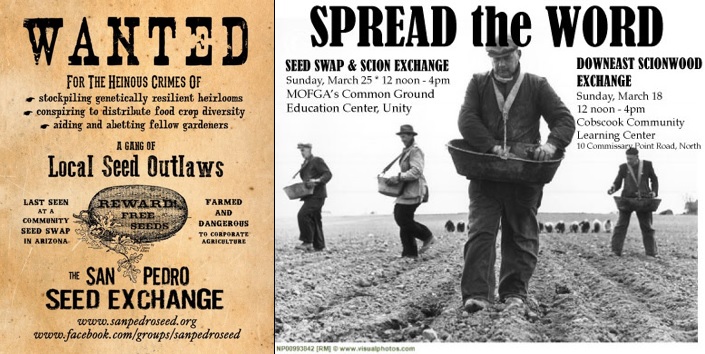




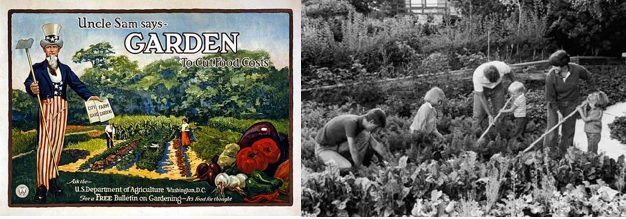
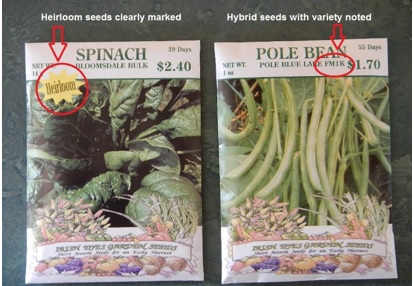
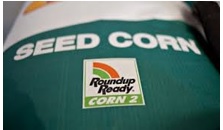
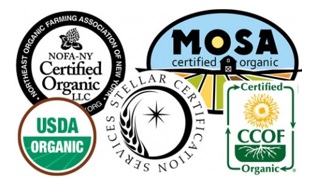
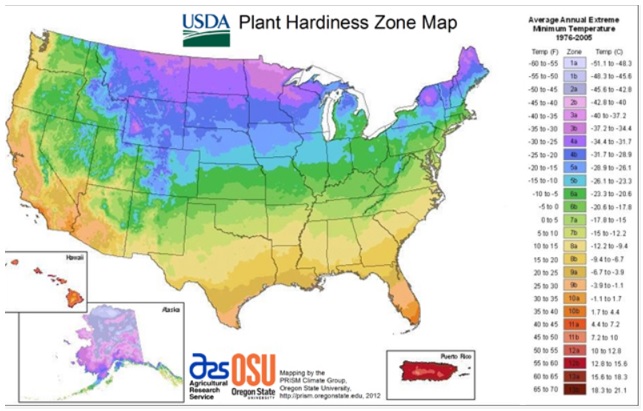

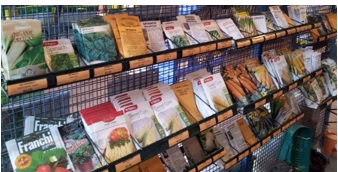

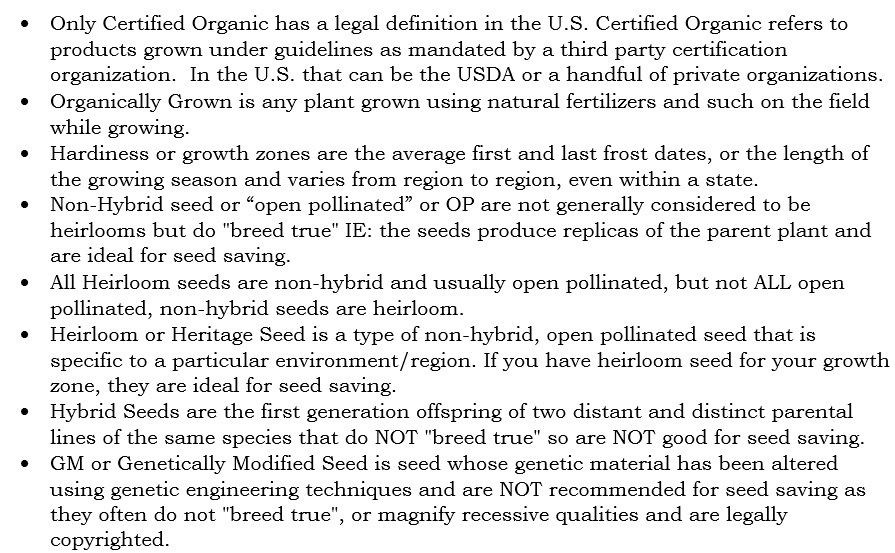
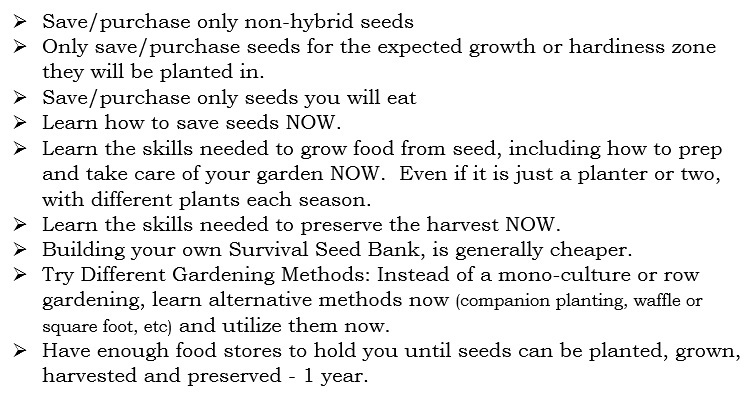

 RSS Feed
RSS Feed
